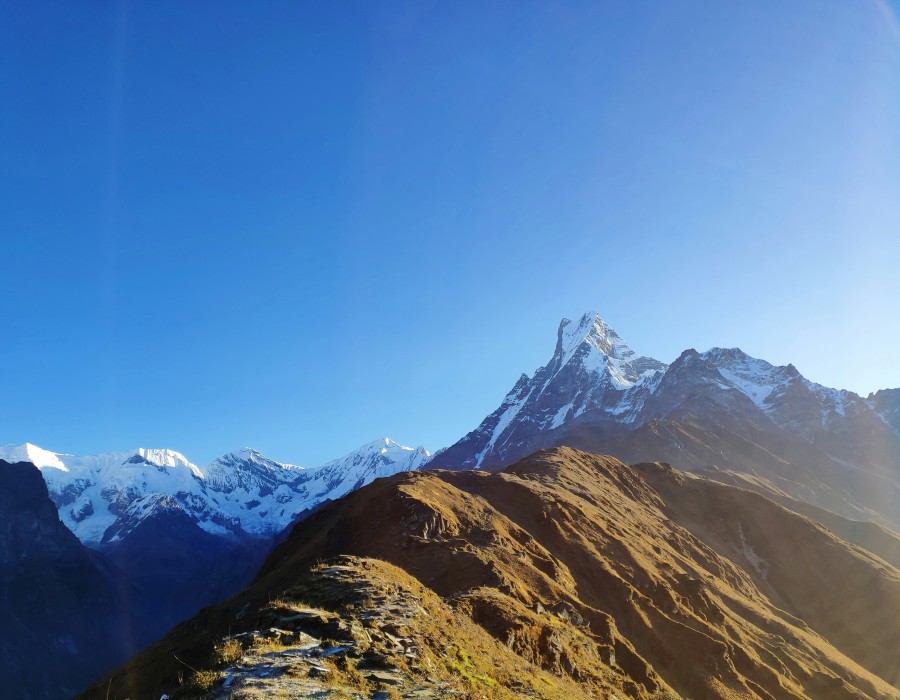The Mardi Himal Trek, which is tucked away in the Annapurna region of Nepal, provides a captivating journey into some of the Himalayas' less-traveled routes. This hike, which is well-known for its quiet landscapes, cultural diversity, and expansive mountain views, is the ideal combination of action and peace. This updated Mardi Himal walk guide explains why it's growing in popularity among hikers looking for both isolation and beauty.
Overview
Location: Mardi Himal is a less congested option with equally breathtaking vistas that is located east of the more well-known Annapurna Base Camp climb.
Distance and Time: The hike is around 40 kilometers long and may be finished in 5 to 7 days. Because of its small size, it is perfect for anyone who want to experience the Himalayas deeply yet have little time.
Route: The journey usually begins in Kande, close to Pokhara, then climbs through Australian Camp, Forest Camp, Low Camp, and High Camp before arriving at 4,500-meter Mardi Himal Base Camp. There are other ways to go back, including going back via Siding or continuing on to other treks like Annapurna Base Camp.
Highlights of the Australian Camp for the Mardi Himal Trek: Provides the mood for the journey with your first expansive views of the Annapurna range.
Rhododendron Forests: These forests turn the hike into a flowery paradise, and they are particularly lovely in the spring.
The trek's high point, Mardi Himal Base Camp, offers hikers a unique viewpoint of the Annapurna sanctuary as well as up-close views of Machhapuchhre (Fishtail) and the Annapurna range.
Cultural Encounters: Trekkers interact with locals as they travel through Gurung villages, taking in customs, food, and the friendliness of the locals.
The Ideal Time to Go Trekking
Spring (March–May): When the rhododendrons blossom, the forests are adorned with vivid hues, and the sky are clear enough to see the mountains.
Autumn (September–November): This season is ideal for trekking because of its clear skies and milder but still bearable temperatures.
Preparation and Equipment Fitness: Although regarded as moderate, the hike includes severe climbs. Walking, hiking, and stair climbing on a regular basis will help you get ready.
Solitude: Mardi Himal offers a more sedate walk than more well-traveled paths, providing opportunities for solitude and reflection in the middle of nature.
Equipment: Well-supported hiking boots for the ankles.
layered apparel (waterproof outer layers, fleece, and a thermal foundation) for a variety of weather conditions.
Sunblock, gloves, sunglasses, and a warm cap.
A lightweight sleeping bag that's perfect for chilly evenings.
A backpack for daily necessities.
Trekking poles to provide stability on rocky terrain.
Lodging and Food
Teahouses: Along the route, simple but comfortable lodges provide meals, beds, and occasionally hot showers. Although the menu changes frequently, it always has favorites like Dal Bhat, which gives you energy for the hike.
Logistics and Permits: You will require a Trekkers' Information Management System (TIMS) card, which can be obtained in Kathmandu or Pokhara, as well as an Annapurna Conservation Area Permit (ACAP).
Guides: Although walking alone was historically usual, foreign trekkers are now obliged to have a licensed guide, which improves safety and supports local jobs, as of April 2023.
Cultural sensitivity includes learning about customs, interacting politely with the locals, and promoting local businesses while trekking.
Why Mardi Himal?
Those who want to experience the Himalayan enchantment away from the masses should consider the Mardi Himal trip. In addition to experiencing a journey that is more about establishing a connection with the natural and cultural surroundings than it is about physically conquering high peaks, it offers the chance to observe the Annapurna range's magnificence from a unique perspective. Mardi Himal delivers a peaceful, culturally diverse, and introspective experience for all trekkers, whether they are experienced or this is their first time in the Himalayas.
Sustainability and Environmental and Cultural Respect: Visitors are urged to embrace eco-friendly behaviors, reducing trash in order to protect the delicate ecosystem.





Comments